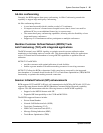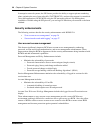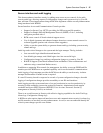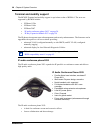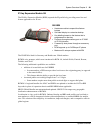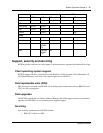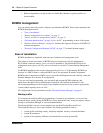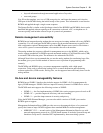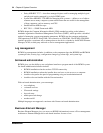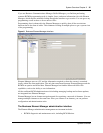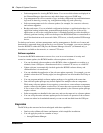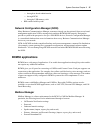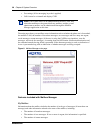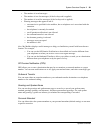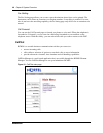
System Overview Chapter 2 33
System Overview
• keycode information through automated application of keycodes
• users and groups
You fill out the template, save it to a USB storage device, and insert the memory stick into the
USB port of the BCM50 during the initial bootup of the system. This information is read into the
BCM50 and applied through a single restart sequence.
The Startup Profile is similar to the Quickstart wizard of the BCM200 and BCM400, but it can be
datafilled and applied without requiring an IP connection to the unit, a PC, or telephone set. It
executes quickly, and includes a broad scope of system-level parameters.
Remote management accessibility
BCM50 has an integrated analog modem that can accept an incoming modem call on any BCM50
system line. You can configure the BCM50 system to let the modem autoanswer a specific line
with configuration options. Management can be from BRI. Remote users can also first initiate a
voice call to a person or an autoattendant, who transfers the call to the modem.
The analog modem also supports callback for management access to the BCM50, which can be
used to support autodialout on SNMP traps and automated sending of Call Detail Records (CDR)
to a remote CDR collection point. The modem is also enhanced with CLID.
Although Nortel does not recommend that you use the analog modem for transferring large files,
the modem gives you a flexible method of remote access to perform all programming tasks
remotely.
The BCM50e and BCM50a give you remote management capability with a high-speed
connection. Tasks such as transferring backup files to a remote destination and transferring
software update files, CDR records, and log files, can be supported more efficiently than over the
analog modem.
On-box and device manageability features
BCM50 has an SNMPv3 interface that includes support for SNMP v1/v2 for management by
legacy SNMP managers. SNMPv3 delivers improved security features for SNMP device access.
The BCM50 main unit supports the following versions of SNMP:
• SNMP v1 — the first implementation of SNMP; this version supports protocols such as IP
• SNMP v2C — provides improved efficiency and error handling
• SNMP v3 — provides improvements in security and privacy
Using the BCM50 Element Manager, you can select which versions of SNMP you want the
BCM50 agent to support.
Management Information Bases (MIB) provide access to the managed objects of a system and
specify the format of traps. BCM50 supports these standard MIBs for remote management:
• MIBII RFC 1213 — second version of the Management Information Base for use with
network management protocols in a TCP/IP-based internet. It includes System Group and
Interfaces Group and is a baseline RFC implemented by data-networking systems.



